
ELS/WS: Extreme Long Shot/Wide Shot
Extreme Long Shot (ELS) - see establishing shot: In this type of shot the camera is at its furthest distance from the subject, emphasising the background. Also known as an establishing shot.
Establishing shot. Opening shot or sequence, frequently an exterior 'General View' as an Extreme Long Shot (ELS). Used to set the scene.
LS:Long Shot
Long shot (LS). Shot which shows all or most of a fairly large subject (for example, a person) and usually much of the surroundings.
MLS: Medium Long Shot
Medium Long Shot (MLS): In the case of a standing actor, the lower frame line cuts off his feet and ankles. Some documentaries with social themes favour keeping people in the longer shots, keeping social circumstances rather than the individual as the focus of attention.
MS: Medium shot
Medium Shot or Mid-Shot (MS). In such a shot the subject or actor and its setting occupy roughly equal areas in the frame. In the case of the standing actor, the lower frame passes through the waist. There is space for hand gestures to be seen.
MCU:Medium Close Up
MCU (Medium Close-Up): head and shoulders.
CU: Close up
Close-up (CU). A picture which shows a fairly small part of the scene, such as a character's face, in great detail so that it fills the screen. It abstracts the subject from a context.
BCU: Big Close Up
BCU (Big Close-Up): forehead to chin. Close-ups focus attention on a person's feelings or reactions, and are sometimes used in interviews to show people in a state of emotional excitement, grief or joy. In interviews, the use of BCUs may emphasise the interviewee's tension and suggest lying or guilt. BCUs are rarely used for important public figures; MCUs are preferred, the camera providing a sense of distance. Note that in western cultures the space within about 24 inches (60 cm) is generally felt to be private space, and BCUs may be invasive.
ECU: Extreme Close Up
ECU (Extreme Close-Up):a particular facial object. The extreme close-up is used to show deep expression or detail to a particular object. For example an extreme close up may be of the watering eye.
The above image and text were all taken from http://www.aber.ac.uk/media/Documents/short/gramtv.html
(Chandler, D : 2001. P.1)



No comments:
Post a Comment